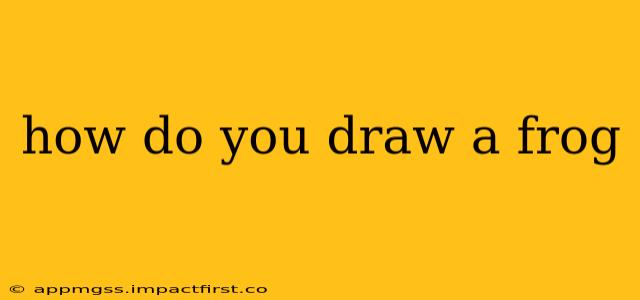How to Draw a Frog: A Step-by-Step Guide for Beginners and Beyond
Drawing a frog can be a fun and rewarding experience, regardless of your skill level. This guide will walk you through several methods, from simple cartoon frogs to more realistic representations. We'll cover different styles and techniques, ensuring you find the perfect approach for your artistic journey.
1. The Simple Cartoon Frog
This method is ideal for beginners and kids. It focuses on basic shapes and requires minimal detail.
- Start with a circle: Draw a large circle for the frog's head.
- Add the body: Attach an oval shape to the bottom of the circle, slightly overlapping. This forms the body.
- Draw the legs: Add four short, slightly curved lines extending from the bottom of the oval. These represent the legs. At the end of each leg, add small circles or ovals for the feet.
- Create the arms: Add two smaller curved lines extending from the sides of the circle, near the junction with the oval. Again, small circles or ovals can serve as hands.
- Add the eyes: Draw two large circles inside the head circle, slightly offset. Add smaller, darker circles inside for the pupils.
- Finish the details: Draw a small, curved line for the mouth. You can add other details like spots or a bumpy texture to the skin.
2. A More Realistic Frog
This method involves more detailed shapes and shading to create a more lifelike representation.
- Sketch the basic form: Begin with a light sketch outlining the overall shape of the frog. This includes the head, body, and legs. Think of it as a simplified silhouette.
- Refine the shapes: Gradually refine the shapes of the head, body, and limbs, paying attention to the proportions and curves. Frogs have distinct features like bulging eyes and a slender body.
- Add detail to the legs: Frog legs are powerful and muscular. Pay close attention to the muscle structure and the webbing between the toes.
- Draw the eyes: Frog eyes are often large and prominent, so give them considerable detail. Consider adding highlights to make them look realistic.
- Define the texture: Use shading techniques to add texture to the skin. Frogs can have smooth, bumpy, or warty skin, depending on the species. Experiment with hatching, cross-hatching, or blending techniques.
- Add finishing touches: Refine the details, erase unnecessary lines, and consider adding a background to complete the drawing.
3. Different Frog Poses and Perspectives
To improve your frog-drawing skills, try drawing frogs in various poses and perspectives.
- Sitting Frog: A simpler pose, ideal for practicing basic shapes and proportions.
- Jumping Frog: A more dynamic pose, requiring more attention to the positioning of limbs and body.
- Side Profile: This perspective allows you to focus on the details of one side of the frog.
- Three-Quarter View: A more challenging perspective requiring understanding of how forms change with angle.
What materials do I need to draw a frog?
You can draw a frog using a variety of materials:
- Pencils: Graphite pencils of varying hardness (e.g., HB, 2B, 4B) are excellent for sketching and shading.
- Pens: Ink pens can create clean lines and allow for detailed work.
- Charcoal: Provides rich dark tones and a textured effect.
- Colored Pencils or Markers: These allow you to add color and bring your frog to life.
- Paper: Use smooth paper for detailed work or textured paper for a more expressive style.
What are some common mistakes when drawing a frog?
- Incorrect proportions: Pay close attention to the relative sizes of the head, body, and limbs.
- Lack of detail: Add details to the eyes, skin texture, and limbs to make your frog more realistic.
- Ignoring perspective: Practice drawing frogs from different angles to improve your understanding of perspective.
By following these steps and experimenting with different styles, you'll be drawing fantastic frogs in no time! Remember, practice makes perfect. Keep drawing, and you'll steadily improve your skills.
